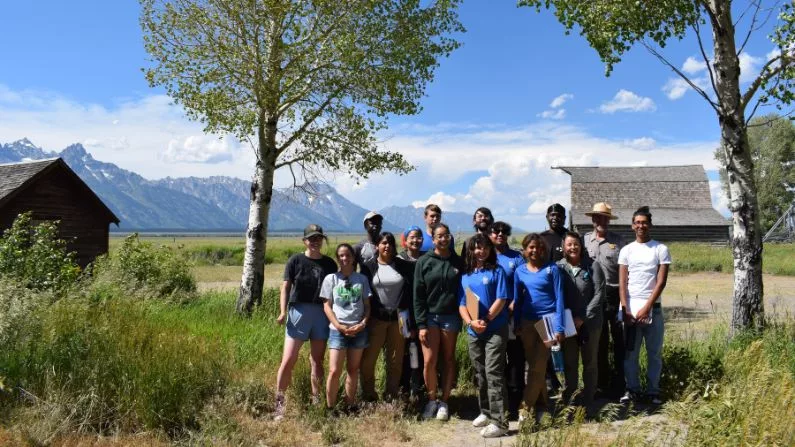High school students from across the country are looking to the Mountain West to learn how to help preserve historic buildings for future generations.
Nine students from a public high school in New York City just wrapped a three-week field trip to Wyoming’s national parks, learning everything from historic masonry to log preservation and wood window repair.
On a hot afternoon last week, they gathered in a sliver of shade under the Pink House, one of Grand Teton’s historic buildings. It’s a home constructed in 1938 by one of the first settlers in the area.
They were trading stories from their trip to Yellowstone. For some, it was their first time camping.
“I was so close to the bison, I mean I felt it rub on the tent next to me,” said Adam Sulla, one of the students.
It was Sulla’s 18th birthday, and he said getting out of New York City has been the best way to spend it.
He said that includes “getting to see actual real grass instead of turf and smell fresh air instead of polluted air. Then getting to see clear skies and then really hear the sounds of the birds and the animals.”
‘What’s important to preserve?’
As part of the culmination of the field trip, Grand Teton Superintendent Chip Jenkins met with the students that day at the Pink House. The group discussed what’s important to preserve in national parks and who gets to decide.
“I feel like the start of the National Park Service was to preserve our parks for the people,” Sulla said to Jenkins.
“Right,” Jenkins responded. “I don’t own Grand Teton National Park. I am here to work on behalf of the American people. I am here to work on behalf of you.”
Their visit is a way to apply what they’ve been learning at the Stephen T. Mather Building Arts and Craftsmanship High School, which helps serve minority students in New York.
Named after the first director of the National Park Service and partly funded by the parks service, the school’s goal is to funnel students into fields like historic preservation.

Aura Pedulo, a recent Stephen T. Mather high school alumni, stands in front of the Pink House off Mormon Row. (Hanna Merzbach/KHOL)
According to Katherine Wonson, who leads programs at the Historic Preservation Training Center at Grand Teton, historic preservation can mean restoring old homesteads, like the Pink House.
“Since the modernization and industrialization of construction, you have an entirely different field of people that has to learn the old ways that we used to construct buildings in order to preserve them,” Wonson said. “So we specialize in that kind of lost and dying art of traditional trades.”
She said, while students come from across the country to learn these trades, it’s Grand Teton’s first year hosting students from this specific school. She also said the programs are part of a greater initiative to diversify who works in and has access to national parks.
“I think the park service is generally opening up and realizing that we need to be more reflective of, you know, the American population,” Wonson said.
Student takeaways
The field trip was a chance to learn about how to preserve cultural resources, but also an opportunity to learn about all types of careers in the national park service.
One student, Ella Lunghi, said spending time with park staff has opened her eyes to new opportunities.
“The whole experience made me truly think about my future and made me realize there were so many paths that I could take and not just be so focused on one,” Lunghi said.
Another student, Aura Pedulo, said she’s leaving the parks feeling inspired, pointing to a project the group worked on in Yellowstone.
“One of my favorite things that I’ve experienced is being able to see the subtle changes that we’ve created, like at the Norris Ranger Museum,” Pedulo said. “It wasn’t like we did something grand, but we definitely did something that’s going to help out in the future and make that building last longer.”
Pedulo and the others said they’re excited to apply what they learned back home in New York — and maybe someday as members of the park service themselves.






